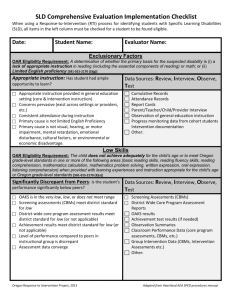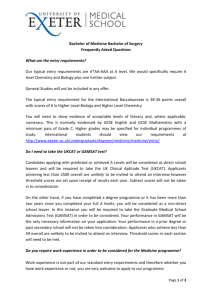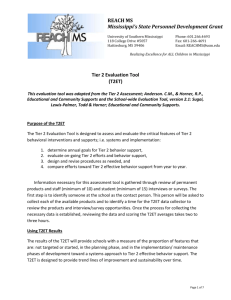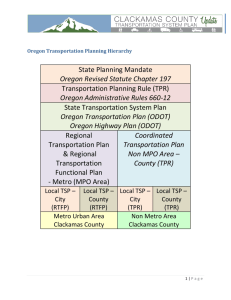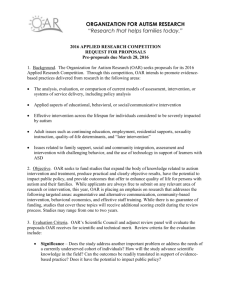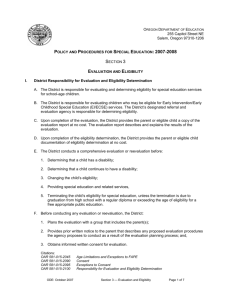SLD Evaluation Implementation Checklist – Fillable copy
advertisement
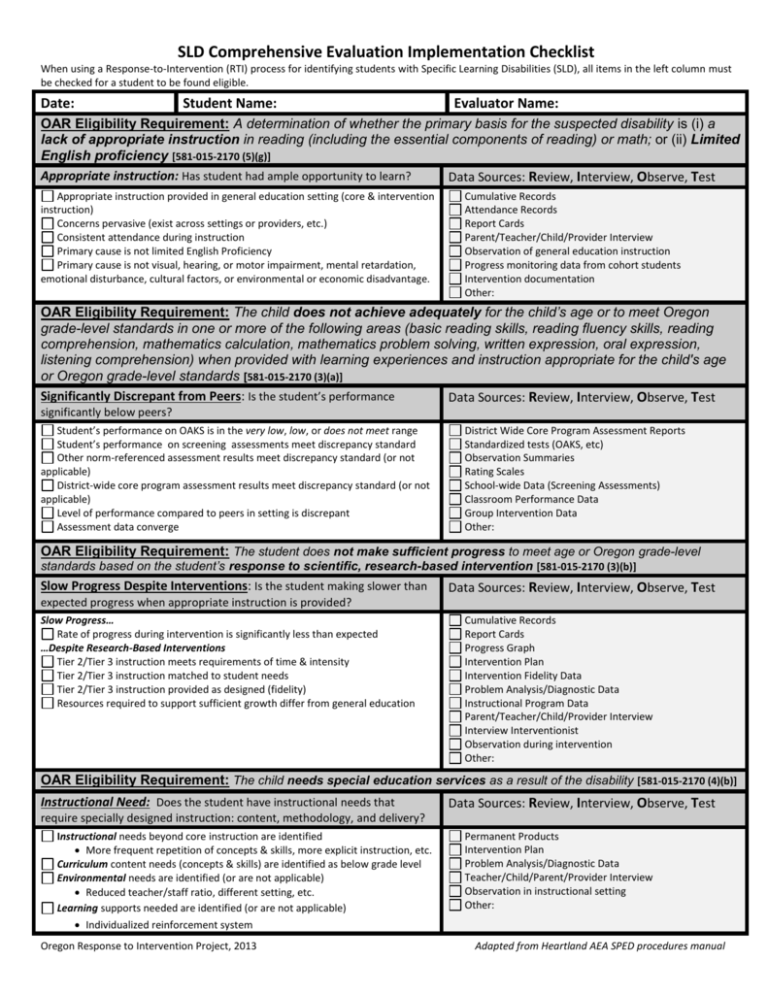
SLD Comprehensive Evaluation Implementation Checklist When using a Response-to-Intervention (RTI) process for identifying students with Specific Learning Disabilities (SLD), all items in the left column must be checked for a student to be found eligible. Date: Student Name: Evaluator Name: OAR Eligibility Requirement: A determination of whether the primary basis for the suspected disability is (i) a lack of appropriate instruction in reading (including the essential components of reading) or math; or (ii) Limited English proficiency [581-015-2170 (5)(g)] Appropriate instruction: Has student had ample opportunity to learn? Data Sources: Review, Interview, Observe, Test Appropriate instruction provided in general education setting (core & intervention instruction) Concerns pervasive (exist across settings or providers, etc.) Consistent attendance during instruction Primary cause is not limited English Proficiency Primary cause is not visual, hearing, or motor impairment, mental retardation, emotional disturbance, cultural factors, or environmental or economic disadvantage. Cumulative Records Attendance Records Report Cards Parent/Teacher/Child/Provider Interview Observation of general education instruction Progress monitoring data from cohort students Intervention documentation Other: OAR Eligibility Requirement: The child does not achieve adequately for the child’s age or to meet Oregon grade-level standards in one or more of the following areas (basic reading skills, reading fluency skills, reading comprehension, mathematics calculation, mathematics problem solving, written expression, oral expression, listening comprehension) when provided with learning experiences and instruction appropriate for the child's age or Oregon grade-level standards [581-015-2170 (3)(a)] Significantly Discrepant from Peers: Is the student’s performance Data Sources: Review, Interview, Observe, Test significantly below peers? Student’s performance on OAKS is in the very low, low, or does not meet range Student’s performance on screening assessments meet discrepancy standard Other norm-referenced assessment results meet discrepancy standard (or not applicable) District-wide core program assessment results meet discrepancy standard (or not applicable) Level of performance compared to peers in setting is discrepant Assessment data converge District Wide Core Program Assessment Reports Standardized tests (OAKS, etc) Observation Summaries Rating Scales School-wide Data (Screening Assessments) Classroom Performance Data Group Intervention Data Other: OAR Eligibility Requirement: The student does not make sufficient progress to meet age or Oregon grade-level standards based on the student’s response to scientific, research-based intervention [581-015-2170 (3)(b)] Slow Progress Despite Interventions: Is the student making slower than Data Sources: Review, Interview, Observe, Test expected progress when appropriate instruction is provided? Slow Progress… Rate of progress during intervention is significantly less than expected …Despite Research-Based Interventions Tier 2/Tier 3 instruction meets requirements of time & intensity Tier 2/Tier 3 instruction matched to student needs Tier 2/Tier 3 instruction provided as designed (fidelity) Resources required to support sufficient growth differ from general education Cumulative Records Report Cards Progress Graph Intervention Plan Intervention Fidelity Data Problem Analysis/Diagnostic Data Instructional Program Data Parent/Teacher/Child/Provider Interview Interview Interventionist Observation during intervention Other: OAR Eligibility Requirement: The child needs special education services as a result of the disability [581-015-2170 (4)(b)] Instructional Need: Does the student have instructional needs that Data Sources: Review, Interview, Observe, Test require specially designed instruction: content, methodology, and delivery? Instructional needs beyond core instruction are identified More frequent repetition of concepts & skills, more explicit instruction, etc. Curriculum content needs (concepts & skills) are identified as below grade level Environmental needs are identified (or are not applicable) Reduced teacher/staff ratio, different setting, etc. Learning supports needed are identified (or are not applicable) Individualized reinforcement system Oregon Response to Intervention Project, 2013 Permanent Products Intervention Plan Problem Analysis/Diagnostic Data Teacher/Child/Parent/Provider Interview Observation in instructional setting Other: Adapted from Heartland AEA SPED procedures manual
